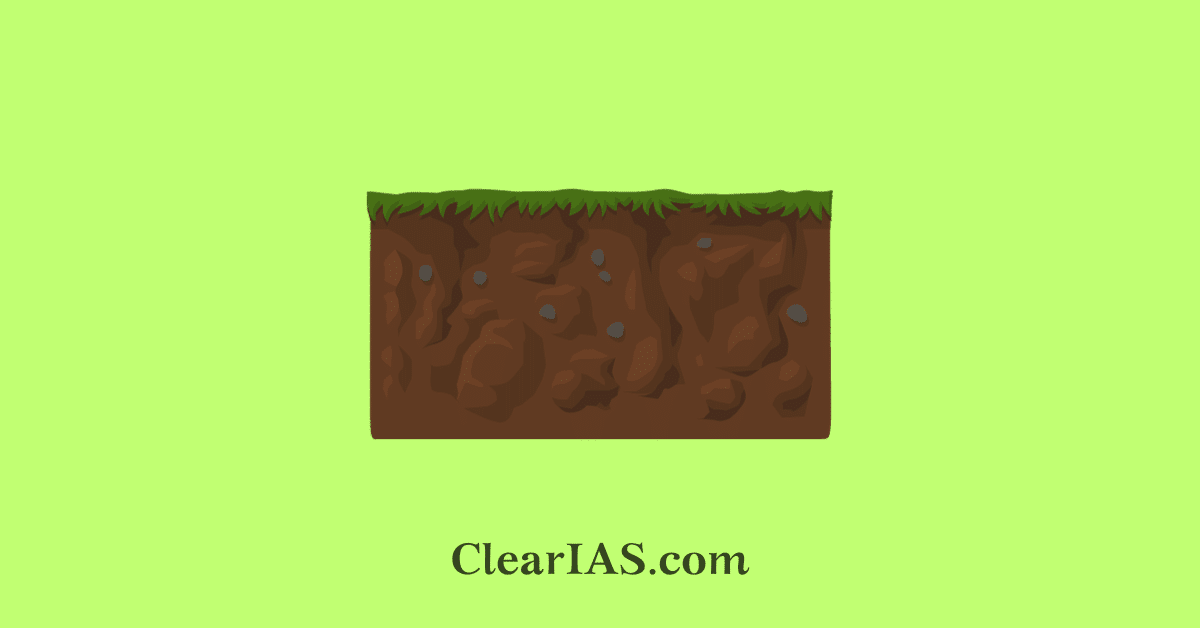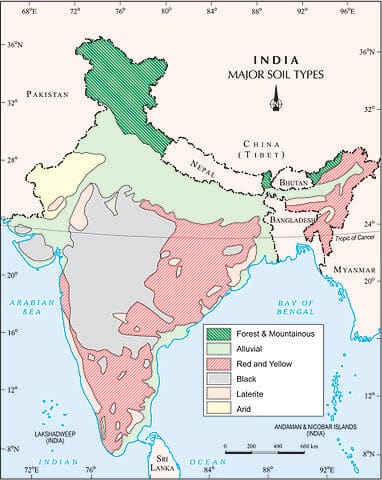
The soils of India are diverse and have led to a rich mosaic of agricultural practices, with different crops and cropping systems suited to specific soil and climatic conditions. Soil management and conservation practices are crucial for sustaining agricultural productivity and food security in the country. India has a diverse range of soils due to its vast geographical and climatic variations. Read here to learn more.
This article is part of our free online study materials in the Geography section. Like the previous articles in the History section, this post – about the classification of soils in India – highlights only the main points from an exam point of view.
From the UPSC exam perspective, aspirants should be aware of nature, color, and nutrients present/absent in each soil type. Recommended reference materials for the topic are NCERT books for Geography.
Now let’s dig deep into the current topic.
Soils of India
Soil can be defined as a mixture of small rock particles/debris and organic materials/ humus that develop on the earth’s surface and support the growth of plants.
Soil Classification – Urvara vs Usara:
In India, soil had been classified from the ancient period itself even though it was not as detailed as the modern classifications.
In the ancient period, the classification was based on only two things; whether the soil was fertile or sterile. Thus the classification was:
- Urvara [fertile]
- Usara [sterile]
In the modern period, when men started to know about the various characteristics of soil they began to classify soil based on texture, color, moisture, etc.
- When the Soil Survey of India was established in 1956, they studied the soils of India and their characteristics.
- The National Bureau of Soil Survey and Land Use Planning, an institute under the control of the Indian Council of Agriculture Research did a lot of studies on Indian soil.
Classification of Soils of India

- Alluvial soil [43%]
- Red soil [18.5%]
- Black/regur soil [15%]
- Arid / desert soil
- Laterite soil
- Saline soil
- Peaty / marshy soil
- Forest soil
- Sub-mountain soil
- Snowfields
Alluvial soil:
- Mostly available soil in India (about 43%) covers an area of 143 sq. km.
- Widespread in northern plains and river valleys.
- In peninsular India, they are primarily found in deltas and estuaries.
- Humus, lime, and organic matter are present.
- Highly fertile.
- Indus-Ganga-Brahmaputhra plain, Narmada-Tapi plain etc are examples.
- They are depositional soil – transported and deposited by rivers, streams, etc.
- Sand content decreases from west to east of the country.
- New alluvium is termed as Khadar and old alluvium is termed as Bhangar.
- Color: Light Grey to Ash Grey.
- Texture: Sandy to silty loam or clay.
- Rich in: potash
- Poor in: phosphorous.
- Wheat, rice, maize, sugarcane, pulses, oilseed, etc. are cultivated mainly.
Red soil:
- Seen mainly in low-rainfall areas.
- Also known as Omnibus group.
- Porous, friable structure.
- Absence of lime, kankar (impure calcium carbonate).
- Deficient in: lime, phosphate, manganese, nitrogen, humus, and potash.
- Color: Red because of Ferric oxide. The lower layer is reddish-yellow or yellow.
- Texture: Sandy to clay and loamy.
- Wheat, cotton, pulses, tobacco, oilseeds, potatoes, etc. are cultivated.
Black soil / regur soil:
- Regur means cotton – the best soil for cotton cultivation.
- Most of the Deccan is occupied by Black soil.
- Mature soil.
- High water retaining capacity.
- Swells and will become sticky when wet and shrink when dried.
- Self-plowing is a characteristic of black soil as it develops wide cracks when dried.
- Rich in: Iron, lime, calcium, potassium, aluminum, and magnesium.
- Deficient in: Nitrogen, phosphorus, and organic matter.
- Color: Deep black to light black.
- Texture: Clayey.
Laterite soil:
- Name from the Latin word ‘Later’ which means Brick.
- It becomes so soft when wet and so hard when dried.
- In the areas of high temperature and high rainfall.
- Formed as a result of high leaching.
- Lime and silica will be leached away from the soil.
- Organic matter in the soil will be removed fast by the bacteria as it is high temperature and humus will be taken quickly by the trees and other plants. Thus, humus content is low.
- Rich in: Iron and Aluminum
- Deficient in: Nitrogen, Potash, Potassium, Lime, Humus
- Color: Red color due to iron oxide.
- Rice, Ragi, Sugarcane, and Cashew nuts are cultivated mainly.
Desert / arid soil:
- Seen under Arid and Semi-Arid conditions.
- Deposited mainly by wind activities.
- High salt content.
- Lack of moisture and Humus.
- Kankar or Impure Calcium carbonate content is high which restricts the infiltration of water.
- Nitrogen is insufficient and Phosphate is normal.
- Texture: Sandy
- Color: Red to Brown.
Peaty / marshy soil:
- Areas of heavy rainfall and high humidity.
- The growth of vegetation is very low.
- A large quantity of dead organic matter/humus which makes the soil alkaline.
- Heavy soil with black color.
- Peaty and marshy soils are found in areas with high water tables, such as the Kerala backwaters and parts of northeastern India. They have high organic content but can be acidic.
- These soils can support wetland agriculture and are suitable for rice and aquatic crops.
Forest soil:
- Forest and hill soils are found in densely forested regions and higher altitudes. They are typically acidic and often have a shallow topsoil layer.
- These soils are essential for maintaining forest ecosystems but are not suitable for intensive agriculture.
Mountain soil:
- Immature soil with low humus and acidic.
- Mountain soils are found in hilly and mountainous regions, including the Himalayas. They are highly weathered and can vary in composition depending on local conditions.
- These soils are suitable for horticulture, tea, and temperate crops like apples and potatoes.
Saline and Alkaline Soils:
- Saline and alkaline soils are found in coastal areas and arid regions. They have high levels of salts and alkalis, making them unsuitable for most crops.
- These soils can be reclaimed for agriculture through drainage and soil amendments.
PS: Also refer to the article ‘Different soil types in India: Understand the differences‘ for a comparative study. Data are given in a table format there.
More articles related to soils: Soil degradation, Monazite soil.
Compiled by: Jijo Sudarsan






mountaineous soil should have high humus ci=ontent because the leaf of the trees having chelation property helps soil gain organic material.
forest soil are rich in carbonic matter not in humus
This content help us to improve our knowledge.
Thanks Sir.
Forest soils are rich in humus
@Shashank and @Ravi: The forest soils vary in structure and texture depending on the mountain environment where they are formed. In the snow-bound areas of the Himalayas, they experience denudation and are acidic with low humus content. The soils found in the lower valleys are fertile. (Reference NCERT – India Physical Environment Page 72). In general in forest soil, as the trees have different root system unlike grasslands, the chance of that to decay and get added as humus in the soil is less.
Thank u for ur brief explaination..
Your article library has given
That forest soil is rich in humus. Actually the ratio of humus depends on its location
Rich in both humus and carbonic matter
Wrong info
You may need GLOBE Soil Chat/Book. JEETEKNO is the only distributor of this Book india. Kindly visit for further details at https://www.jeetekno.com. Mobile: 9897800710.
Munsell Soil Color Chart / Book at JEETEKNO. Visit https://www.jeetekno.com. Mobile: 9897800710, e-mail: [email protected].
it is not clean but it is ok !!!!!!!!!!
Upsc syllabus in world soils
Hello
Plz provide the types of soil in states of India,, e. g. Transported soil is at rajasthan
Plz, Classification and type of west bengal soil.
kindly verify the extent of Alluvial soils
Black soil and alluvial if combined form a complete soil …which will yield any type of crop
what are the characteristics of red soils.
please give the info in brief points.
alluvial soil covers an area of 143 sq km ???!?!?!!! that is too less.
NO YOUR WRONG ! ALLUVIAL SOIL COVERS 43% OF INDIA
WHICH IS SO HI
Alluvial soil covers 45.6% of total land area of indua
Alluvial soil covers approximately 15 lakhs sq.km
Alluvial soil covers 14.25 lakhs sq. Km that is 43.4% of all over
Thanks , it was really helpful
It is really nice for each participants thanks to clear ias
Hi
please give percentage of different type of soil
Thanks for the details
write the features of White soil also please.
Very helpful …. Good work….
Pics don’t make me confuse now ..
Admin way dey ol r syng ..d matter is correct or wrong
How do soil properties change ?
Do these changes takes place each year. How it effect on food production and food security?
Thanks for description. Munsell Soil Color Chart is useful for purpose.
Alluvial soil is rich in phosphorus and poor in nitrogen content and humus..but here given as poor in phosphorus pls clarify my ambiguity
okay but alluvial sil cover is tooooooo less in kilometer
Which soil order highest in india
In which state of india there is maximum area of acidic soil and what is the reason behind it.
Which soil is the most important in India from the agriculture point of view?
It is very useful.It enhances the knowledge.It may bring good results in the field of farming & gardening.
Dear delegates
I need standard physico-chemical parameters of soil for INDIA
Hoping to be replied soon
Thanks
Nice explanation. Thanks
Forward soil textures will ne according to the mountain environmental the place they are formed.
In this lesson, you mentioned that Laterite soils are deficient in “Potash”, but in continuation to this lesson i.e., “Different soil types in India: Understand the differences using an Easy-to-Learn Table”, you had written Laterite soils are rich in “Iron oxide and Potash” which is totally contradicting. Kindly check.
Please correct “Alluvial soil covers more than 15 lakh sq km” instead of 143 sq km.
What is the CBR strength of the soil in Bundelkhand region.?
Exactly how many types of Soil in India?
Peaty Soil, According to NCERT it says there is good vegetation.
You have mentioned low vegetation.
Alluvial soil has lack of humus pls update it
where is saline soils
contain large portion of sodium potassium and magnesium
high slat and infertile
occurs in arid and semi arid region
texture – sandy to loamy
lack in nitrogen and calcium
western coast of gujart and eastern deltas and sunderban
most points are missing
It was very helpful for my Diwali project